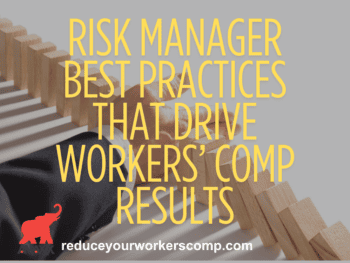As an employer, you often hear the recommendation “stay involved in your workers’ compensation claims.” That is great advice, but way too often it’s where the discussion ends without any explanation as to what “staying involved” means.
Four Phases of Employer Involvement in Workers’ Comp Claim
The employer’s involvement in the workers’ comp claim begins before the injury occurs and ends when the employee is back at work, fully recovered from the injury. Let’s first look at four phases of employer’s involvement in the workers’ comp claim, then we will look at what the employer cannot do in regards to the workers’ comp claims.
Click Link to Access Free PDF Download
The four phases are:
- Pre-injury process
- The injury occurrence
- The claim process
- The claim settlement
If you have employees, sooner or later an employee is injured on the job. The following are some suggestions about what you can do prior to the injury occurring that will impact on the outcome of the workers’ comp claim. Make sure you have “touch points” for each phase of the claim.
Here is an example of what is appropriate:
- Provide each new hire with an employee accident brochure outlining what the employee should do in case of an accidental injury.
- Have a written transitional duty policy.
- Provide each supervisor within the company a written guide on how they are to report and be involved in workers comp claims.
- Post the injury procedure policy where all employees will see it.
- Have a published returned to work policy.
- Have a strong safety program and tie the manager’s performance evaluation, raise, bonus or promotion to his or her safety record.
- Have a medical provider network in place through your insurance company or join a medical provider network for self-insureds. Make sure all employees know about and use the network. This is called your “penetration” — you should have a penetration rate of > than 90%.
- Prevent fraud by letting all employees know workers comp fraud takes money away from their raises and bonuses.
- Put up posters reminding the employee that workers comp fraud is a crime and will be fully prosecuted.
FREE DOWNLOAD: “5 Critical Metrics To Measure Workers’ Comp Success”
- Post all the state required notices in a place convenient for all employees to see including workers comp laws, OSHA posters and anything else required in your state.
- Post a list of the required medical providers (where allowed by state statute) or recommended medical facilities (in the states where the employee is allowed to select their own doctor). Consider using an outcome-based network where providers with exemplary performance are included in the network.

Author Rebecca Shafer, JD, President of Amaxx Risk Solutions, Inc. is a national expert in the field of workers compensation. She is a writer, speaker, and publisher. Her expertise is working with employers to reduce workers compensation costs, and her clients include airlines, healthcare, printing/publishing, pharmaceuticals, retail, hospitality, and manufacturing. She is the co-author of the #1 selling book on cost containment, Workers Compensation Management Program: Reduce Costs 20% to 50%. Contact:.
Contact: RShafer@ReduceYourWorkersComp.com.
Workers’ Comp Roundup Blog: https://blog.reduceyourworkerscomp.com/
©2018 Amaxx LLC. All rights reserved under International Copyright Law.
Do not use this information without independent verification. All state laws vary. You should consult with your insurance broker, attorney, or qualified professional.
FREE DOWNLOAD: “5 Critical Metrics To Measure Workers’ Comp Success”
















